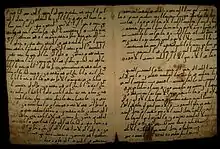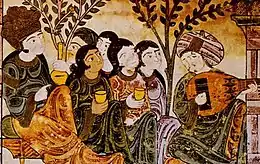Hijazi script
Hijazi script (Arabic: خَطّ حِجَازِيّ ḫaṭṭ ḥijāzīy), also Hejazi, literally "relating to Hejaz", is the collective name for a number of early Arabic scripts that developed in the Hejaz region of the Arabian Peninsula, which includes the cities of Mecca and Medina. This type of script was already in use at the time of the emergence of Islam.

| Part of a series on |
| Arabic culture |
|---|
 |
Earlier scripts included the Ancient North Arabian and South Arabian script
Hijazi was one of the earliest scripts, along with Mashq and Kufic.
The script is notably angular in comparison with other Arabic scripts and tends to slope to the right. The script does not yet contain any dots or diacritical marks to indicate vowel sounds: but does differentiate consonants by the intermittent use of dashes above the graphic letter forms.
Māʾil (مائل, "sloping") script is a calligraphic Hijazi script found in a number of the earliest Qur'anic manuscripts. The two terms are often used interchangeably.
References
External links
- British Library MS. Or. 2165 Early Qur'anic manuscript written in Ma'il script, 7th or 8th century CE
- British Library MS. Or. 2165 (British Library)
- Ma'il manuscript from the Tareq Rajab Museum in Kuwait.
- Folio in an italic Hijazi script from the discoveries at the Great Mosque, Sana'a
- Fragment in a Makkan Hijazi script from the Vatican library
